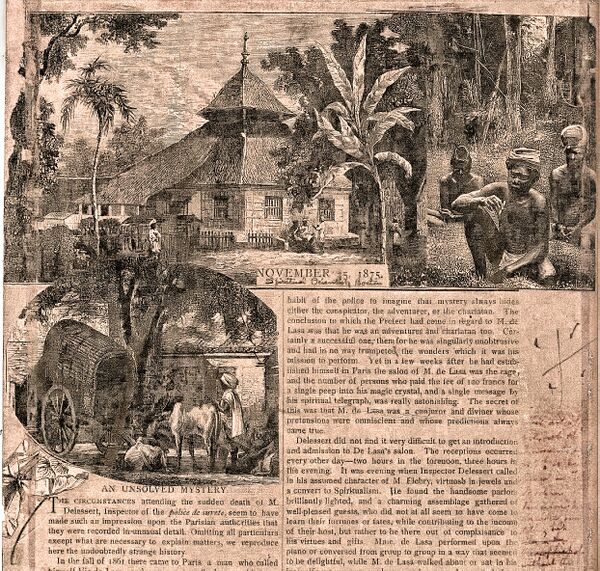
An Unsolved Mystery
The circumstances attending the sudden death of M. Delessert, inspector of the Police de Sûreté, seems to have made such an impression upon the Parisian authorities that they were recorded in unusual detail. Omitting all particulars except what are necessary to explain matters, we reproduce here the undoubtedly strange history.
In the fall of 1861 there came to Paris a man who called himself Vic de Lassa, and was so inscribed upon his passport. He came from Vienna, and said he was a Hungarian, who owned estates on the borders of the Banat, not far from Zenta. He was a small man, aged thirty-five, with pale and mysterious face, long blonde hair, a vague, wandering blue eye, and a mouth of singular firmness. He dressed carelessly and ineffectively, and spoke and talked without much empressement. His companion, presumably his wife, on the other hand, ten years younger than himself, was a strikingly beautiful woman, of that dark, rich, velvety, luscious, pure Hungarian type which is so nigh akin to the gipsy blood. At the theatres, on the Bois, at the cafés, on the boulevards, and everywhere that idle Paris disports itself, Madame Aimée de Lassa attracted great attention and made a sensation.
They lodged in luxurious apartments on the Rue Richelieu, frequented the best places, received good company, entertained handsomely, and acted in every way as if possessed of considerable wealth. Lassa had always a good balance chez Schneider, Reuter et Cie., the Austrian Bankers in Rue de Rivoli, and wore diamonds of conspicuous lustre.
How did it happen then, that the Prefect of Police saw fit to suspect Monsieur and Madame de Lassa, and detailed Paul Delessert, one of the most rusé inspectors of the force, to “pipe” him? The fact is, the insignificant man with the splendid wife was a very mysterious personage, and it is the habit of the police to imagine that mystery always hides either the conspirator, the adventurer, or the charlatan. The conclusion to which the Prefect had come in regard to M. de Lassa was that he was an adventurer and charlatan too. Certainly a successful one, then, for he was singularly unobtrusive and had in no way trumpeted the wonders which it was his mission to perform, yet in a few weeks after he had established himself in Paris the salon of M. de Lassa was the rage, and the number of persons who paid the fee of 100 francs for a single peep into his magic crystal, and a single message by his spiritual telegraph, was really astonishing. The secret of this was that M. de Lassa was a conjurer and diviner, whose pretensions were omniscient and whose predictions always came true.
Delessert did not find it very difficult to get an introduction and admission to de Lassa’s salon. The receptions occurred every other day—two hours in the forenoon, three hours in the evening. It was evening when Inspector Delessert called in his assumed character of M. Flabry, virtuoso in jewels and a convert to Spiritualism. He found the handsome parlors brilliantly lighted, and a charming assemblage gathered of well-pleased guests, who did not at all seem to have come to learn their fortunes or fates, while contributing to the income of their host, but rather to be there out of complaisance to his virtues and gifts.
Mme. de Lassa performed upon the piano or conversed from group to group in a way that seemed to be delightful, while M. de Lassa walked about or sat in his insignificant, unconcerned way, saying a word now and then, but seeming to shun everything that was conspicuous. Servants handed about refreshments, ices, cordials, wines, etc., and Delessert could have fancied himself [to have] dropped in upon a quite modest evening entertainment, altogether en règle, but for one or two noticeable circumstances which his observant eyes quickly took in.
Except when their host or hostess was within hearing, the guests conversed together in low tones, rather mysteriously, and with not quite so much laughter as is usual on such occasions. At intervals a very tall and dignified footman would come to a guest, and, with a profound bow, present him a card on a silver salver. The guest would then go out, preceded by the solemn servant, but when he or she returned to the salon—some did not return at all—they invariably wore a dazed or puzzled look, were confused, astonished, frightened, or amused. All this was so unmistakably genuine, and de Lassa and his wife seemed so unconcerned amidst it all, not to say distinct from it all, that Delessert could not avoid being forcibly struck and considerably puzzled.
Two or three little incidents, which came under Delessert’s own immediate observation, will suffice to make plain the character of the impressions made upon those present. A couple of gentlemen, both young, both of good social condition, and evidently very intimate friends, were conversing <... continues on page 1-82 >
Editor's notes
Sources
-
Archivist note (improved image)
See also
- <SB, vol.3, pp.133-35>


